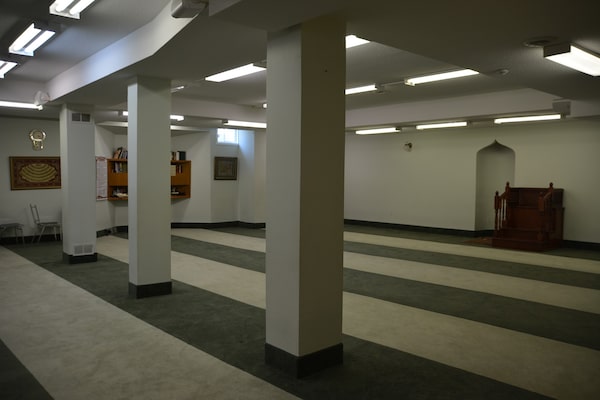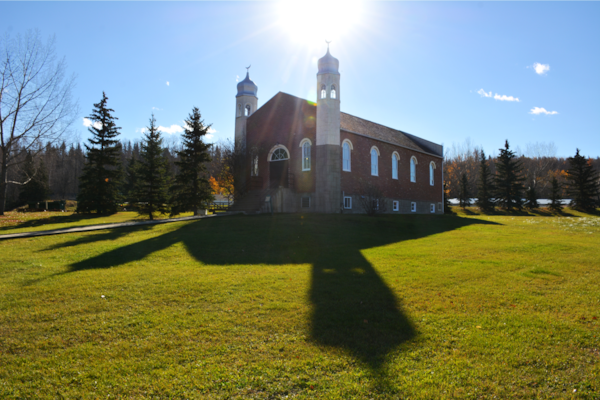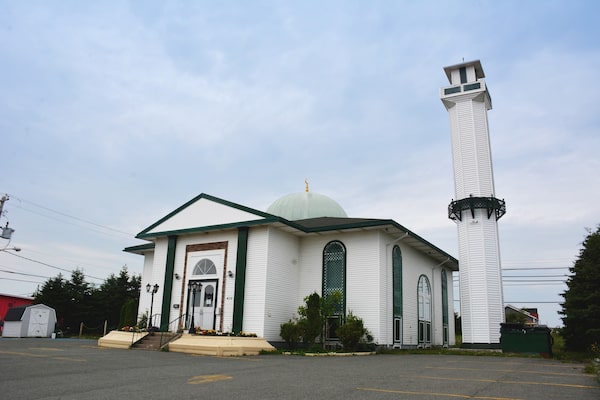
The Midnight Sun Mosque in Inuvik, N.W.T., is the northernmost mosque on the continent. Due to extreme cold, it was constructed in Winnipeg and transported 4,500 km to its current location.Tammy Gaber/Handout
While growing up in Karachi, I spent most of my childhood at my local mosque, one of the few spaces where my parents could let their guard down in a city reputed for crime. I loved going for Friday prayers on the back of my grandpa’s Vespa, seeing my friends without supervision and getting there early enough to call dibs on the “window seat” – the first row of a wooden balcony on the second floor, which was the only way for women to see the big marble and gold decorated interior on the main floor for men.
For these limited, coveted spots, I’ve seen women come in hours early or a day before to tape down a prayer mat as a placeholder. I’ve even witnessed fights under the echo of the adhan (the call to prayer) for these spots.
In Canada, the mosque is still my safe place, and the competition for favourable seating among women also remains the same. Where I live now, the mosque is far, and we can’t always get there early. I’ve spent many Ramadans in the basement with cracking audio and screaming babies, fantasizing about palace-like mosques with ample seating like the ones back home.
When thinking about some of the world’s great mosques, Canada doesn’t really top the charts; there’s nothing that glamorous here. But Tammy Gaber, who documented 90 mosques from a variety of Islamic sects in 53 Canadian cities in less than three years, has found something truly special about the Canadian mosque: They are much more than a place for religious gatherings.

Dr. Tammy Gaber, Director and Associate Professor of Architecture at Laurentian University's McEwen School of Architecture. in Sudbury, ON.Tammy Gaber/Handout
Gaber, an architecture professor at Laurentian University, dissects what many might mistake for ordinary in her new book Beyond the divide: A Century of Canadian Mosque Design, a “labour of love” project she started in 2015. Jessica Hanzelkova and Safira Lakhani, her two research assistants, also helped make the project become a reality.
Through floor plans, photography and conversations, she celebrates the diversity and versatility of mosques, Islamic centres, prayer spaces, and jamatkhanas (multipurpose gathering spaces) across Canada while remaining critical of design methods and their impact on the community.
Gaber spoke with me about how gendered division, community input and each province’s unique socio-political climate have influenced the architecture of these community spaces.
Why research mosques here?
The Canadian mosque is maybe visually not as impressive as Cairo, Istanbul or Delhi. But here, mosques are hubs of activity. I wanted to tell the story of the people in the communities that did bake sales and saved money to convert a small building, like the one in Edmonton, which was converted from a casino. They didn’t spend much of the fundraised money on the conversion because part of this mosque functions as a soup kitchen, and they wanted to be able to give more food out. I saw mosques being loaned out for citizenship ceremonies and for the screening of hockey games and youth clubs.

The Al Quba Masjid in downtown Edmonton is housed in a converted casino hall. The exterior has very little modification as the limited funds were focused on modifying the interior.Tammy Gaber/Handout
In your work, you delve into this interesting space of design and gender segregation, something a lot of Muslim women have noted. What did you find?
The interior and its design impact decisions on how people use a space. There was a small percentage of mosques that have all access, with a good view that women can participate in.
But not all separations are equal. At the Islamic Society of North America in Mississauga, there is a really low glass wall between the areas for men and women, so you feel like you’re in the same space. Then there are places where they put women in the basement or a whole separate room with no window and a shaky audiovisual system. Some have balconies that allow you view or cover your view.
:format(jpeg)/cloudfront-us-east-1.images.arcpublishing.com/tgam/KZ7UN67YUJH7HOR424QTYPCEPM.jpg)
:format(jpeg)/cloudfront-us-east-1.images.arcpublishing.com/tgam/FYDBPM4U4ZBLXBE6L5V324KFSE.jpg)
:format(jpeg)/cloudfront-us-east-1.images.arcpublishing.com/tgam/B44I2I4JQFDYPIPV7XAHV5V5CA.jpg)
Why is the view so important?
When you’re in prayer, praying with other people, like when I was in Mecca at the Kaaba, I knew how to follow along because I could see other people’s actions and I could hear what was being said at the same time that everyone else was hearing it. It’s about feeling like you are the same as anyone else.
Did you come across other gendered divisions or differences?
Yes, the entrance. How you enter a building sets you up for your experience. If you’re entering from a back entrance, and it’s a small door that’s poorly connected, it’s going to set you up for not feeling so welcome, versus the main entrance, in which you can socialize and not have to cram your shoes in a corner. I found that the issue of the separate entrances was amplified with the mosques that had very clear separate prayer spaces for men and women.
The problem is that the architect is not asking enough questions. In the best of designs, like the ones of Sharif Senbel, an architect in B.C. who’s done so many mosques, he’d listen to the community, not only three or four people, and he’d show them his designs and get feedback

Masjid Al Salam in Burnaby, B.C. was designed by architect Sharif Senbel.Tammy Gaber/Handout

The main prayer hall of the Islamic Society of Niagara Peninsula Mosque, where men pray in the front and women behind without any divider. Women have a full view of the main space.Tammy Gaber/Handout
Did you find any Canadian mosques doing things more progressively in terms of spaces for women? Can you give me an example?
In mosques like the one in Niagara Falls, which never had a separation in their prayer area, the board represents the cross-section of the community. This decision was part of the governance from the founding of the mosque to the management and the conversations they had with the community. The current president of the mosque is a woman. As I was interviewing her, her children were entering the space and using it. The impact is that you get participation.
If division and the way it’s done is a choice, where does it stem from?
For the first 700 years, there were no architectural separations built into mosques to separate men and women. Segregation became more of an influence of the Byzantine Empire, like in the time of the Hagia Sofia, which was originally a church with a separate space for women and became a mosque after. A lot of the Ottoman mosques are actually inspired by Hagia Sofia. The influence is cross-cultural.
What would you say is a really unique thing about the way Canadian mosques are designed compared to other more historically Islamic parts of the world?
Each region in Canada has its own style of design. In Alberta, you can see the theme of pioneering communities in the very first mosque in Canada, one that still exists, the Al Rashid in Edmonton, which embodies this idea.
In Quebec, the majority of mosques are converted spaces, and there are legislative reasons, such as zoning laws, which have led to this. In British Columbia, a larger proportion of mosques are purpose-built and designed very consciously. Part of this reason is the large and diverse Muslim population and the collective ability of groups like the British Columbia Muslim Association who have financially supported the construction of many mosques throughout the province. There’s a lot of timber, a lot of glued laminated timber, in their industry that is reflected in their mosques. When you’re using local materials, you’re responding to local needs.

The Al Rashid mosque in Fort Edmonton Park, AB, is the first purpose-built mosque in Canada. It was built in 1938.

The Mosquee Noor Al Islam in North Montreal is housed in a converted former car garage, with extensive modifications to the exterior, including the addition of a neo-historicist minaret.Tammy Gaber/Handout
In the Maritimes, which has historically been a place of transition, mosques really function as community centres because the Muslim population has doubled in recent years due to the influx of Syrian refugees.

The Muslim Association of Newfoundland and Labrador in St John’s uses an abstracted historic design with generic domes and minaret.Tammy Gaber/Handout
In Newfoundland, the mosque in St. John’s is really cool because the finishing is like that of a lighthouse. This mosque has this feeling of a maritime building. To save money in the design process, the dome is actually a prefabricated silo dome.
When we talk about the extreme north, we acknowledge qibla orientation because Muslims pray in the direction of Mecca. Generally, mosques in Canada face some degree of north, but you can’t look at a flat map of the world to orient because we’re on a globe. The shortest distance from northern Canada to Mecca is just north, not East. So, the mosque in Inuvik faces North.
So, the answer isn’t that there’s a type of Canadian mosque. The answer is that there’s a type for every province.
This interview has been edited and condensed for clarity.



